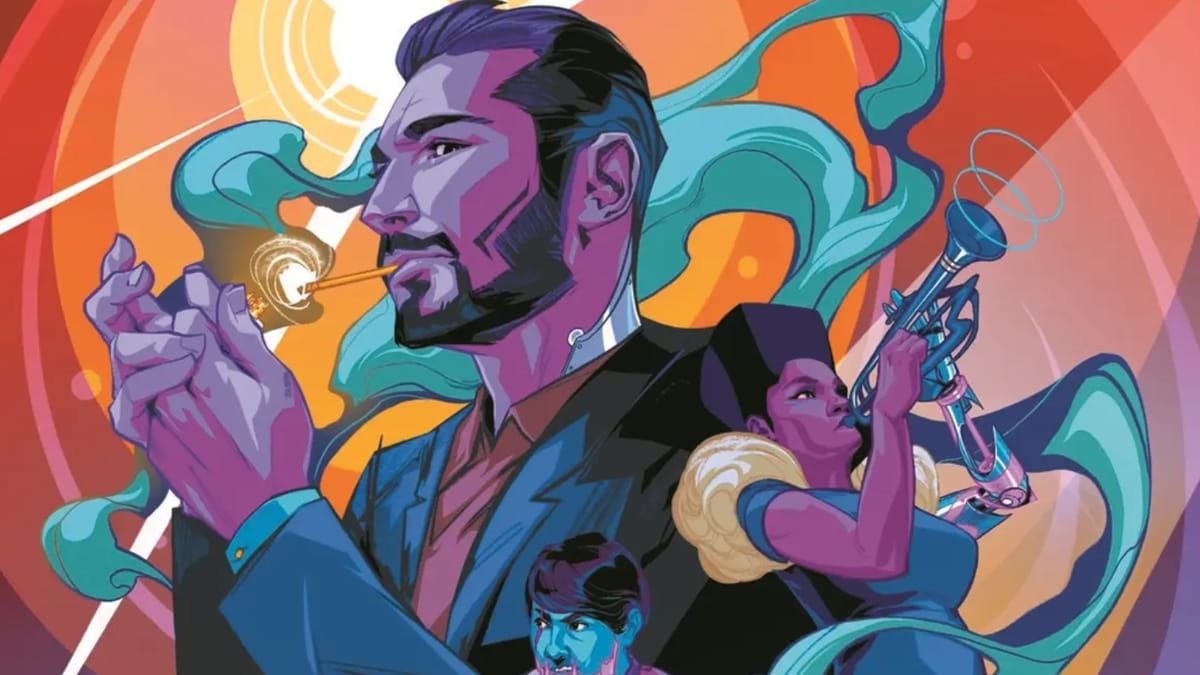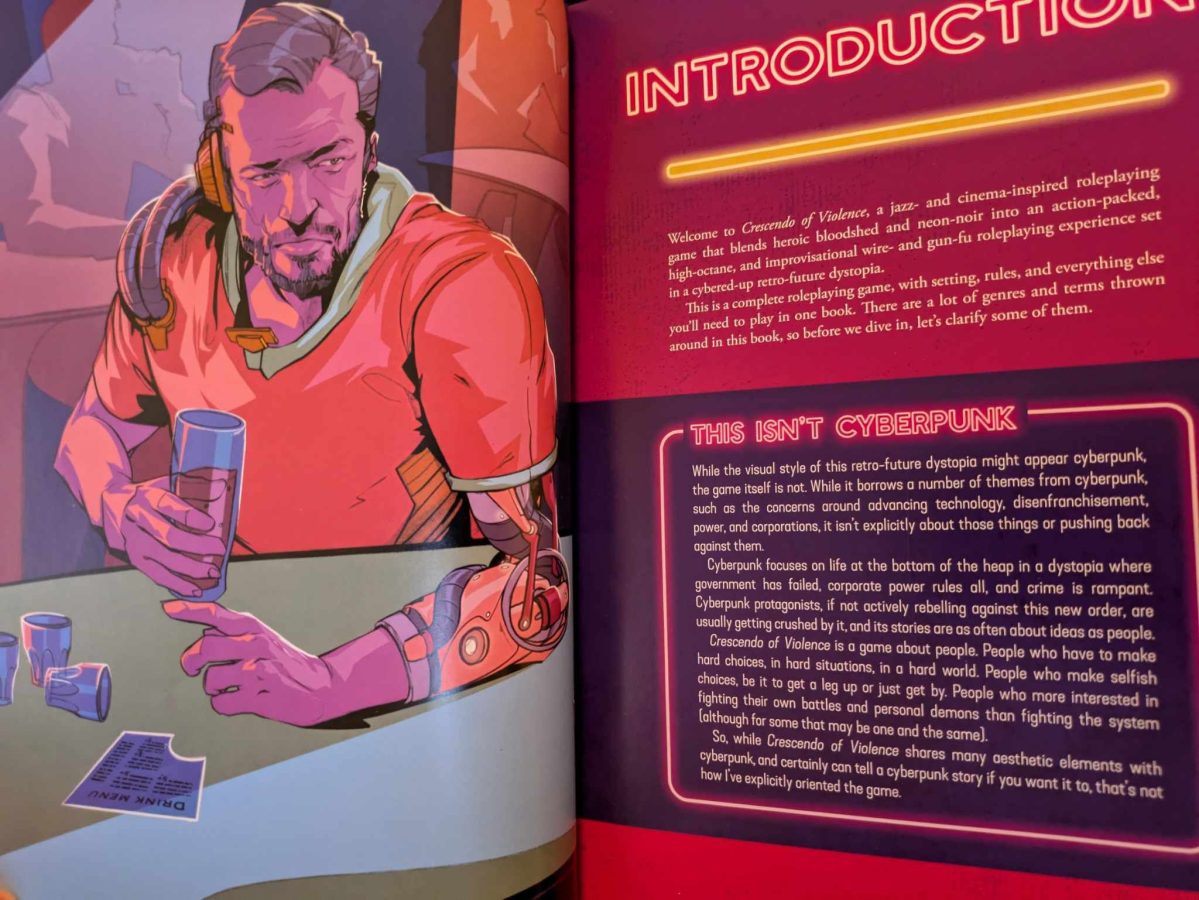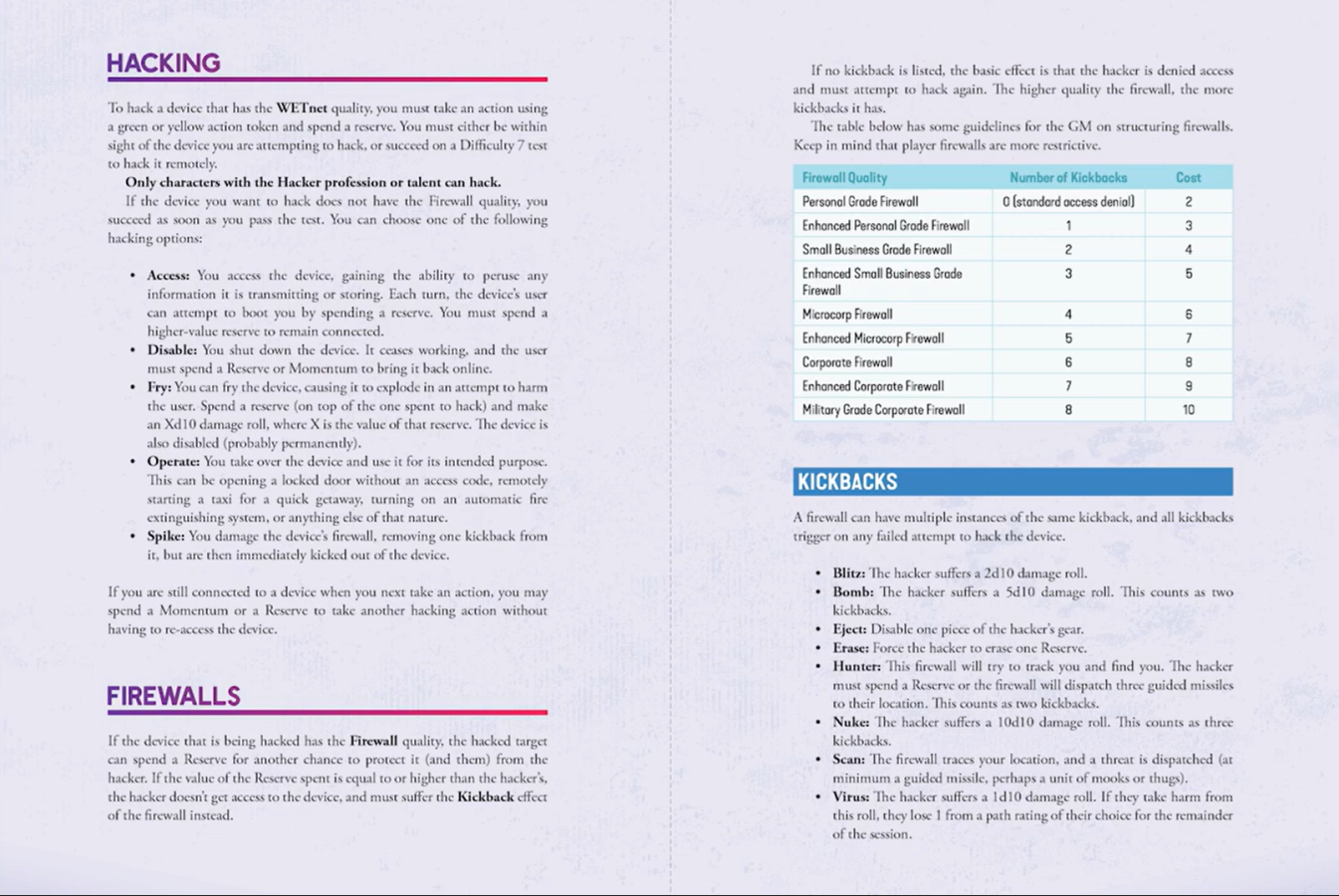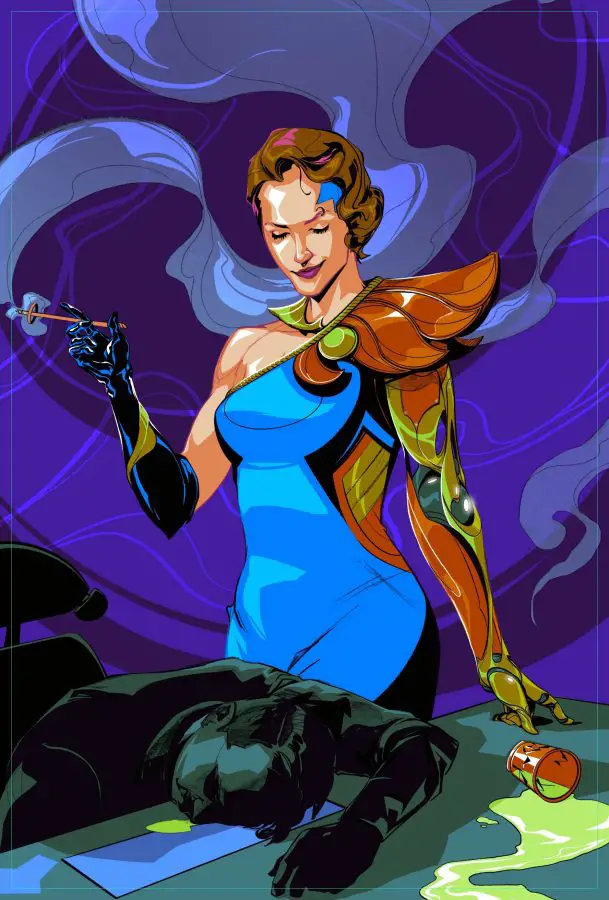
Crescendo of Violence is a work of thought, care, and dedication by author Alan Bahr. Taking place in a post-post cataclysmic Neo York, the jazzy action game is laden with complimentary pinks, greens, and purples. It’s 143 pages packed with style. Careful readers will notice that nothing I just said actually implies that Crescendo of Violence rounds out into a good game, and that’s because no amount of style or heart from Bahr covers for the game’s confusion about its own identity. The rules and setting are driven by something, undoubtedly, but that drive doesn’t manage to get it across the finish line of being a RPG that holds together in the end.
The full title is Crescendo of Violence: A Neon-Noir Roleplaying Game, and the book starts with a lengthy discussion of genre and this game’s place within genre. Not to be confused with cynical mystery revival neo-noir, neon noir is characterized by…being more colorful? There are many pages of discussion and good critical quotes about noir, but it all ends up talking about what CoV isn’t, as opposed to what it is. Genre is a sticky subject; it’s a series of categories, but too strict adherence to category limits discussion into drawing pointless lines and talking about which side certain things are on. For instance, there is no real substance to the question of whether Avatar: the Last Airbender is an anime or not. It doesn’t really matter, and you have to be pretty stupid to bother arguing about the subject in the first place. You might as well get into a fistfight over whether a hotdog is a sandwich. It’s an exercise in semantics that doesn’t change anything about the actual experience unless you really want it to.
All that being said, CoV takes careful pains to review its place within the noir genre, and I as reviewer am tasked with responding to those pains and asking whether they add meaningfully to the book. In short, I don’t think so. CoV makes clear that it is NOT cyberpunk, despite the fact that its one main subsystem is for hacking and it contains many of the same influences. That’s fine, cyberpunk is an inherently cynical genre and we don’t all want to play around in that hopeless grime. Whereas “[C]yberpunk focuses on life at the bottom of the heap in a dystopia” this game is about people fighting their own demons and trying to make their own way. Really, those aren’t elements of cyberpunk stories? That isn’t how I recall Neuromancer or Snow Crash or Altered Carbon, but okay, I’ll go with you for a while. You’re leaning harder on the noir aspect of this setting. That being said, what’s the dividing line between the neo and the neon?

CoV says its differentiating factor is setting and visual style. The visuals of the book are strong, but don’t translate to the tabletop, unless you are constantly setting the mood in game by evoking a specific visual style and lighting your game room accordingly. The influences it names, like Blade Runner, the Big Sleep, and Strange Days, don’t carry that style. Cowboy Bebop is the only one that feels like it comes close, but nowhere are mentions of things like Inherent Vice, Under the Silver Lake, or Too Old to Die Young. I know it seems odd that I’m spending so much time on this, but that’s only because it’s central to the ethos of what this book is trying to communicate. So many pages and words out here telling us that this game definitely isn’t cyberpunk or standard noir, but when it actually gets to the point of telling us what Crescendo of Violence does stand for, it basically amounts to “yeah it’s just cyberpunk and noir.” You could have said that and added that you’re going for a bit more of a jazz-punk, grounded influence, but instead waste page space out the gate introducing us to not much at all. I would be hard-pressed to give you a reason not to cut this entire section from the book.
That all said, the presentation is generally nice. The neon pages are replete with art selling a very cyberpunk New Orleans, tommy guns and trumpets beating out their tones against a dark sky lit with flying police cruisers filtered through the rain. It’s got a style I would love to see more of, in any medium that can take it. The book is small enough to carry without issue but has a good hard cover and thick pages that will let it survive whatever carrying bag you decide for it. The text rarely fills its pages, and comes with a small font, making me wish someone had increased the size across the board. With such empty space on the pages in a small book, it would have made it much more readable.
After the genre talk it has some discussion of RPGs in general and then gets into the setting of Neo-York. A timeline sets out the number of catastrophes that reshape the world, with tidal power and new technologies setting it back on its wavering feet. This section does admirable work explaining the city, its power structures, its neighborhoods, and its lifestyles. I would really appreciate a map of this central setting, but the book’s visuals are almost exclusively people. No maps, no logos for the megacorps, no equipment, but in a game about people and relationships I don’t know that I can call foul there. One of the better additions here are bolded terms for a few important setting details, to make it easier to reference later on or quickly get your head around.
The game itself is fast and cinematic, getting you right into the action with…hold on. You’ve heard this before haven’t you? The clarion call of a game being sort of half a game? It eschews petty granular considerations like “having enough rules to make its own point” because it wants to evoke the slick action of John Wick. Yes, among its influences are not just cynical mystery genres, but the stylistic gun fu of old Hong Kong movies. I don’t mean to sound resentful here, but I do have to point out a seeming contradiction: in a game that wants to be about people finding their way in a heartless world, the only rules at play are focused on hacking and action set-pieces. Those rules, as it happens, aren’t very many.

Each character has 8 attributes: Cautious, Clever, Dramatic, Empathetic, Fast, Resolute, Sneaky, and Violent. Rolls consist of rolling d10s equal to an attribute, taking the highest die, and comparing it to a set difficulty level. If you fail you either suffer a real failure or succeed with a cost at the GM’s discretion. The game has no rules for initiative, trading out for a nebulous discussion of Spotlight shifting between characters. It does have rules for range and cover, for the many gunfights you’ll be getting into.
Though there are no rules for the order of actions, the order of actions remains crucial because of Action Tokens. Red, yellow, and green, these represent the shifting flow of a scene. Each action you’ll have to use one, gaining -1d10, neutral, or +1d10 respectively. You have to use all three before you can recharge, though there are abilities that play into this system and allow you to change things around. Your Reserve pool can help mitigate these issues. Damage causes you to lose Momentum, your green or yellow token, or be knocked out for a while. In the later acts this can switch over into death.
Now it may seem confusing that I reference Momentum, Reserve, and Acts without telling you what they are, and that’s because I’m trying to translate the feeling of reading this book. The rules section is all backwards. You get through MANY references to rules you haven’t been introduced to. Advancement and GM advice both come before character generation and equipment. Downtime rules reference traits of NPC allies you won’t have heard of before. Many of those rules are themselves fine, but the awkward way they’re spaced out will leave you with some confusion.

Reserve are values you roll early and can hold onto, switching them out later to choose better or worse rolls, or triggering for some other bonuses during the game. You gain Momentum when rolling a 10, and can spend those points for things like taking another action, seizing the Spotlight, or gaining a token back. See, there is no initiative system, but there are rules that interact with or rely on this nebulous, implied initiative system. Why not just have a hard and fast rule for it? Even one as simple as saying outright that everyone needs to go once before you can take another turn? This is what I’m talking about with thinking there aren’t enough rules here. In not having rules like initiative, you just raise questions and leave gaps in the game. Why do I need a resource for taking extra turns if there is no turn structure?
While there is no structure for the action scenes, the only type of scene this game is built to model is for the adventure as a whole. Each session is meant to be broken into five acts. Some rules and abilities tie into these acts, such as character death. Generally this is a helpful way to suggest GMs structure their games, though what it amounts to is arguable. You have the introduction, pretty much everything that takes up the adventure itself, the calm before the storm, the climax, and finally the denouement. A few of those acts take up the vast bulk of the runtime, but it is nice to see some advice on how to give life to an in-game story.
Starting at page 95 we have character generation. Though you only have 8 attributes, there are some fun options with the equipment and abilities, featuring many shades of allies, gene modifications, rounding out with the Hacking rules and sample NPCs. With six weapon mods and five armor mods, those options are pretty limited.
At the end of the day, there is one real mechanic that governs everything, the basic d10 vs. difficulty roll. Reserve and Momentum offer minor modifications, and Hacking gives you something else to do, but none of those serve to create a variety of feelings during gameplay. It’s certainly quick to learn and use, which facilitates general of action, but not the kind of fluid violence that seems to be the real, intended goal. In play it does move quickly, but not in a way that I felt conveyed a sense of genre or tone. Just a series of rolls which vary in difficulty as you trade resources around. You do have some choices to make, but they are rarely ones that are all that hard: do you use the scant resources at your disposal to your benefit or not? When do you give yourself the occasional disadvantages?
There is some style and thought put into this game, but I struggle to see how it all fits together. It has some complexity in the form of various action tokens, Reserve, and Momentum, but why? Why have the modifications for equipment in a game that’s trying to cut down on tactical complexity? Why have so many options when those options come down to various meta-resources you can string together? Why tie all of this into a vague act structure and half-initiative system? Why play this when Cities Without Number has a 227 page free version? I don’t hate or even really dislike Crescendo of Violence. I just find its creative decisions confusing and contradictory. It works, and I’m sure the right groups can find fun in its ethos of not-quite noir and not-quite cyberpunk. What I’ve yet to be convinced of is whether that effort is really worth it at the end of the day. With less effort you could play something more tactical or more narrative, without sitting at this awkward middle-ground.
Crescendo of Violence
Mediocre
Crescendo of Violence is a game that spends a lot of effort to explore itself in both rules and text, but I’m not sure if that effort gets it anywhere. There is a playable game and some interesting ideas at the heart of this book, though I can’t help but feel that neither are explored that effectively. The look and feel of it are wonderful, though the overall package is a more complicated offering.
Pros
- Wonderful depiction of rainy, jazz-punk Neo York
- Fast, intuitive rules to get you into the game
- Small but high quality rulebook makes for ease of transport and reading
Cons
- The rules’ complexity isn’t tooled towards its intended output
- The game feels confused in both its narrative and mechanical genres
- Layout decisions make this hard to comprehend
